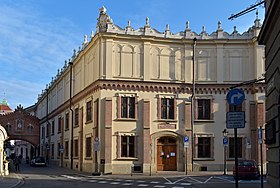
Back متحف تشارتوريسكي Arabic متحف تشارتوريسكى ARZ Музей Чартарыйскіх Byelorussian Музэй Чартарыйскіх BE-X-OLD Музей на князете Чарториски в Краков Bulgarian Museu Czartoryski Catalan Muzeum knížat Czartoryských Czech Czartoryski-Museum German Μουσείο Τσαρτορίσκι Greek Muzeo Czartoryski Esperanto
 | |
 | |
| Established | 1878 |
|---|---|
| Location | Pijarska Street 15 Kraków, Poland |
| Type | National museum |
| Director | Jolanta Lenkiewicz |
| Website | Muzeum Czartoryskich |
The Princes Czartoryski Museum (Polish: Muzeum Książąt Czartoryskich [muˈzɛ.um ˈkɕɔ̃ʐɔnt t͡ʂartɔˈrɨskʲix]) – often abbreviated to Czartoryski Museum – is a historic museum in Kraków, Poland, and one of the country's oldest museums. The initial collection was formed in 1796 in Puławy by Princess Izabela Czartoryska. The Museum officially opened in 1878.[1] It is now a division of the National Museum in Kraków.
The Puławy collection was partly destroyed after the November 1830 Uprising and the confiscation of the Czartoryski properties. Most of the Museum holdings, however, were saved and moved to Paris, where they reposed at the Hôtel Lambert. In 1870 Prince Władysław Czartoryski decided to move the collections to Kraków, where they arrived in 1876.
The most renowned painting at the Museum is one of Leonardo da Vinci's best-known works, the Lady with an Ermine. Other highlights include two works by Rembrandt; several antiquities, including sculptures; Renaissance tapestries and decorative arts; and paintings by Hans Holbein the Younger, Jacob Jordaens, Luca Giordano, Pieter Brueghel the Younger, Dieric Bouts, Joos van Cleve, Lorenzo Lotto, Lucas Cranach the Younger, Lorenzo Monaco, Andrea Mantegna, Alessandro Magnasco, and the Master of the Female Half-Lengths.
The Museum's main facility closed for restoration in 2010 and reopened in December 2019.[2] During this time, parts of the collection were displayed at other venues.[3]
- ^ Olivia Petrides, Anthem Guide to the Art Galleries and Museums of Europe. Page 509. Anthem Press, 2009, ISBN 1-84331-273-5.
- ^ ""The Lady is back!". Po blisko dekadzie królowa polskich muzeów wróciła na swoje miejsce". Retrieved 20 December 2019.
- ^ "Princes Czartoryski Museum in Krakow | Muzeum Czartoryskich". www.krakow-info.com. Retrieved Apr 27, 2020.